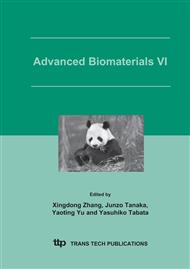p.469
p.473
p.477
p.481
p.485
p.491
p.495
p.499
p.503
Synthesis and Biocompatibility Evaluation of Poly(HEMA-Co-MMA) Orbital Implant
Abstract:
Orbital implant, used for filling the space after enucleation, played an important role in the optical orthopedic operations. However, the clinical application of soft orbital implants was in a limited extent. This paper focused on the synthetic method of a new kind of soft poly (2-hydroxyethyl methacrylate) (PHEMA) orbital implant. This method included two steps, making the orbital implant with through-holes by salt leaking method and improving the compress property of PHEMA by copolymerizing it with methyl methacrylate (MMA). Scanning electronic microscope (SEM), thermo gravimetric analysis (TGA), and compress experiment were carried out to evaluate the physical properties of the implant. And to evaluate the biocompatibility of this poly (HEMA-co-MMA) orbital implant, short term and long term observations were studied after subcutaneous implantation of material blocks and implantation of orbital implants (diameter in 14mm) in rabbits’ orbits.
Info:
Periodical:
Pages:
485-490
Citation:
Online since:
June 2005
Authors:
Keywords:
Price:
Сopyright:
© 2005 Trans Tech Publications Ltd. All Rights Reserved
Share:
Citation:


